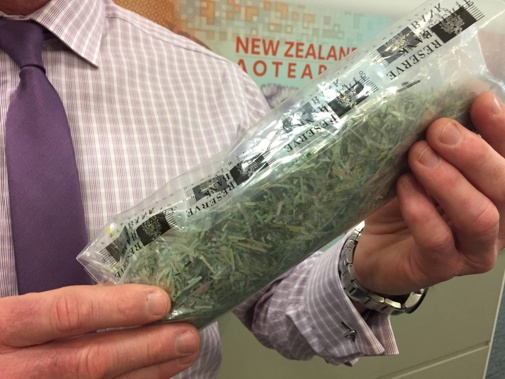
Nearly one billion dollars in cash notes has been destroyed in 2017 as New Zealand's old bank notes are taken out of circulation.
Hundreds of millions of dollars in bank notes are slowly being shredded into millionaire confetti and being recycled into everyday plastic items, such as clothesline pegs and pot plant holders.
The amount of money being destroyed is higher than usual this year as the old series of notes and coins are cycled out and the new Series 7 notes are cycled in, said Reserve Bank head of currency, property and security Steve Gordon.
There is about five and a half billion New Zealand dollars circulating at the moment - in the country and offshore - and hundreds of thousands of notes being destroyed every week.
In 2016, the Reserve Bank destroyed 43 million notes, with a value around $1 billion.
The money is "granulated" down into "very small sort of confetti-sized bits of bank notes" then sent away to a specialised company that recycles them into plastic items one might find at home.
When the Reserve Bank isn't getting rid of the old series of bank notes, the most common reason to destroy cash is for wear and tear.
On average, about 20 million notes are declared unfit for circulation per year.
All this money being transformed into plastic on a weekly basis must be replaced.
New Zealand money is printed much less frequently than it is destroyed, and it's done overseas.
"It might be every year or two, perhaps, that we would place an order . . . typically being a mass-produced product, when we place an order it's a big order, maybe a hundred million or more physical forms," Gordon said.
A hundred million notes, depending on what types of notes were being printed, could quickly add up to billions of dollars.
With the money being printed overseas, the Reserve Bank has a variety of ways to transfer the notes over here - and this sometimes involves secretly putting "a fairly small amount" on a commercial flight.
In Reserve Bank language, a "fairly small amount" of money is about $100 million in cash, which unsuspecting passengers could find themselves sharing a plane with.
The notes are printed in Canada because it is not financially viable to run a printing factory in New Zealand. With money only ordered once a year at most, such a factory would lie unused much of the time.
Planning an order of money is no small job, but planning a new series of bank notes is one that might be started 10 years in advance.
"They're very complex things, bank notes," Gordon said.
Each new design comes with refreshed security measures to combat counterfeiting.
The counterfeit rate in New Zealand is "the envy of the rest of the world". Measured in "parts per million", our country has a counterfeit rate of only one part per million, which can be attributed in large part to the security features of the money.
Despite the increased use of Eftpos cards and online banking, the amount of New Zealand cash circulating here and overseas is growing, something that "around the currency world gets discussed a fair bit".
There are a few "industry theories" on why the around $5.5b in cash is growing. One is that low interest rates means it doesn't "hurt as much" to hold on to cash.
"You're not losing interest revenue by holding it to any extent."
Other reasons could include that New Zealand money was popular overseas, people using cash to avoid taxation, and using cash in the "dark economy" for illegal dealings.
But another thought was simply that increased spending led to increased needs for cash.
One way or another, the Reserve Bank has so far always had enough to circulate, and didn't have "masses of unused notes sitting around".
Money, money, money
- Nearly one billion dollars in cash notes destroyed in 2017
- 43 million notes, with a value around $1 billion, destroyed in 2016
- About five and a half billion dollars circulating at the moment
- About a hundred million or more notes printed every year or two
- On average, about 20 million notes are declared unfit for circulation per year
Take your Radio, Podcasts and Music with you








